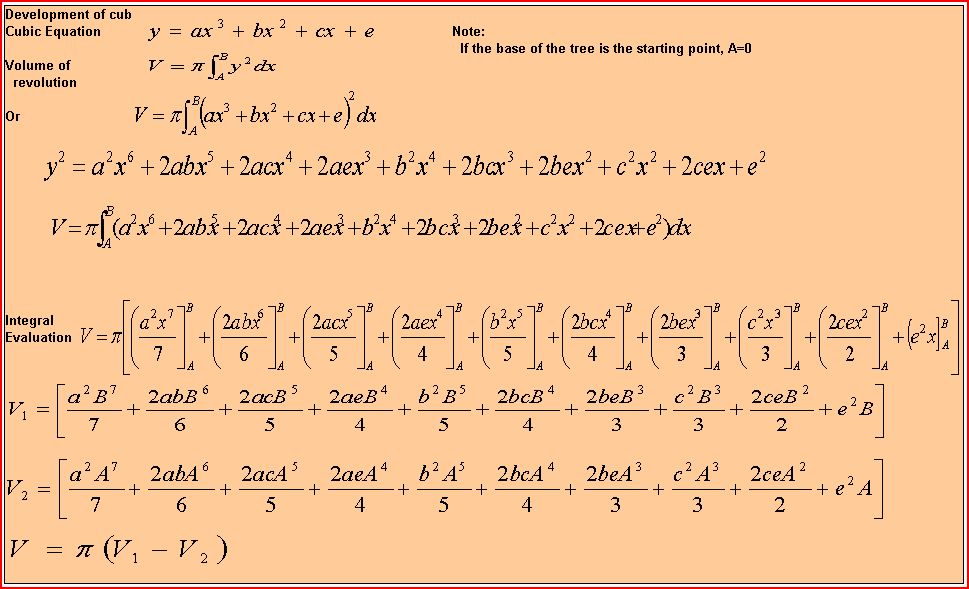|
ENTS,
On November
1, 2008 , President of ENTS Will Blozan and new Ent from PA Mike
Dunn climbed the Jake Swamp white pine in Mohawk Trail State Forest
, Charlemont , MA . Will tape drop measured the Jake tree, as we
call it, to an impressive height of 168.5 feet, tallest in New
England . That height was within 0.1 feet of my most probable
ground-based measurement and 0.4 feet of John Knuerr ís single
measurement.
While descending the Jake tree, Will took 17 circumference
measurements at points he chose based on where he saw a change of
form. Willís measurements were taken from a height of 130 feet down
to ground-level. The remaining part of Jake, i.e from 130 to 168.5
feet was modeled as a right circular cone. The portion from
ground-level to 130 feet was modeled as a series of frustums of
right circular cones. Using the formula for a frustum that weíve
often repeated in emails, a volume of 581.9 cubic feet was obtain
for the section from base to 130 feet. At a dinner at the Charlemont
Inn, Willís quick calculations produced 573 cubes. Iím unsure of
where the discrepancy lies. The remainder of the trunk volume above
130 feet was approximated at 17.2 cubic feet. The total volume of
the frustums and final cone equals 599.1 cubes. That is the modeled
trunk volume of Jake following the protocol that weíve previously
applied.
The question arises as to what volume we might derive were we to
develop a regression-based model using height above base as the
independent variable and radius as the dependent. This question was
answered with the help of Minitab 13, a statistical software
package. The three models below show the results. The first assumes
a linear relationship, the second fits a parabola to the data, and
the third fits a cubic equation (3 rd degree polynomial).
Based on the high degree of fit for the cubic equation, an Excel
workbook was developed that reflects all the modeling work. The
workbook is provided as the attachment. However, the 3 rd
spreadsheet in the workbook can be used as a standalone worksheet.
The method used in the spreadsheet is explained after presentation
of the models.
Regression
Analysis: C2 versus C1 (linear)
The
regression equation is
C2 = 1.68 -
0.00802 C1
Predictor
Coef
SE Coef
T
P
Constant
1.68283
0.02591
64.95
0.000
C1
-0.0080216
0.0003677
-21.81
0.000
S = 0.06257
R-Sq = 97.1%
R-Sq(adj) = 96.9%
Analysis of
Variance
Source
DF
SS
MS
F
P
Regression
1
1.8628
1.8628
475.87
0.000
Residual
Error 14
0.0548
0.0039
Total
15
1.9177
Unusual
Observations
Obs
C1
C2
Fit
SE Fit
Residual
St Resid
1
3
1.8167
1.6628
0.0252
0.1539
2.69R
R denotes
an observation with a large standardized residual
Polynomial
Regression Analysis: C2 versus C1 (parabola)
The
regression equation is
C2 =
1.68798 - 0.0083477 C1
+ 0.0000027 C1**2
S =
0.0647927
R-Sq = 97.2 %
R-Sq(adj) = 96.7 %
Analysis of
Variance
Source
DF
SS
MS
F
P
Regression
2
1.86308 0.931540
221.896 0.000
Error
13
0.05458 0.004198
Total
15
1.91765
Source
DF
Seq SS
F
P
Linear
1
1.86285
475.867 0.000
Quadratic
1
0.00023
0.055 0.819
Polynomial
Regression Analysis: C2 versus C1 (cubic)
The
regression equation is
C2 =
1.73507 - 0.0144310 C1
+ 0.0001269 C1**2 -
0.0000006 C1**3
S =
0.0582937
R-Sq = 97.9 %
R-Sq(adj) = 97.3 %
Analysis of
Variance
Source
DF
SS
MS
F
P
Regression
3
1.87688 0.625626
184.107 0.000
Error
12
0.04078 0.003398
Total
15
1.91765
Source
DF
Seq SS
F
P
Linear
1
1.86285
475.867 0.000
Quadratic
1 0.00023
0.055 0.819
Cubic
1
0.01380
4.060 0.067
How does one take any of the above regression models and calculate
trunk volume? It is fairly straightforward. All t hese models
predict trunk radius at specified heights above the base of the tree
(actually from an arbitrary starting at one point on the trunk and
going to another). If we plot the graph of the regression equation
with radius on the Y axis and height on the X axis, we can then
imagine rotating the radius curve around the X axis to generate a
three-dimensional image of the trunk. Integral calculus then gives
us a method of computing the volume of the generated geometric
solid. Spreadsheet 2 (EvalOf Integral) of the attached workbook
shows the resul. T he third spreadsheet (CalFinalVol) applies the
process to the Jake Tree. The volume derived through the regression
cubic model is about 17 cubes larger than the model developed by
adding the volumes of the separate frustums. The frustum model is
the more accurate.
I pass by observing that spreadsheet 3 can stand alone. If the
user supplies values for the coefficients of the cubic equation and
the beginning and ending heights (limits of integration), the
spreadsheet calculates the trunk volume automatically. As with all
my spreadsheets, the green cells are for user input. The remaining
cells are protected. Oh yes, there is also a provision for adding a
separate amount such as a conical determination of the top of the
tree from the point of highest circumference measurement to the tip.
The amount added could just as easily be at the bottom of the tree
or a combination of sections. Basically, t he cubic equation can be
used to model a section of trunk. Different equations could be
developed to model different trunk segments based on w hat the
educated eye sees as different areas of curvature that could not be
modeled well by one equation .
Equation derivation requires a regression program to compute the
coefficients of the cubic equation. Statistical programs are
available, but I plan to develop a spreadsheet version so that the
Ents who donít want to wade through statistical software packages
can rely on a single spreadsheet model that only requires the input
radial and height measurements, then generates the cubic equation
and performs the integration to arrive at trunk volume.
Bob

Continued at:
http://groups.google.com/group/entstrees/browse_thread/thread/28e3b4add9afb1b7?hl=en
|